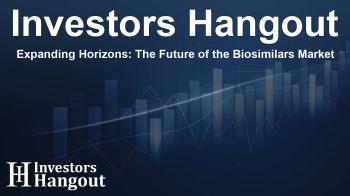Expanding Horizons: The Future of the Biosimilars Market

Growth Forecast for the Biosimilars Market
The global biosimilars market is set to witness remarkable expansion, with predictions suggesting a leap from $22.58 billion in 2024 to an impressive $171.79 billion by 2033. This growth trajectory reflects a compound annual growth rate (CAGR) of 25.5% over this period. Several factors are contributing to this robust increase, including the uptick in regulatory approvals, the expiration of patents for significant biologic drugs, and a rising prevalence of chronic diseases such as cancer and diabetes.
Understanding Biosimilars
Biosimilars represent follow-on versions of biologics, which are complex medicines derived from living organisms. Unlike their reference biologics, biosimilars offer comparable efficacy and safety, typically at 20-35% lower costs, thus making treatments more accessible worldwide. This affordability is a game changer, particularly in regions where healthcare costs pose significant barriers.
Regional Market Trends and Drivers
Among the regions leading the growth of the biosimilars market, the Asia-Pacific area shows promising trends, notably in Japan. Thanks to robust government support, favorable reimbursement strategies, and increased acceptance among healthcare practitioners, Japan has successfully expanded its biosimilars portfolio. The Japan Biosimilar Association was launched to address barriers to adoption, enhancing the market's responsiveness to medical needs.
Japan's Leading Role
Take, for example, the spectacular uptake of Filgrastim BS in Japan, which captured around 45% market share shortly after its launch. Other biosimilars like Insulin glargine BS have also seen rapid adoption. The country's initiatives, such as the Honebuto policy, alongside reforms in national health insurance, further encourage the usage of biosimilars.
Economic Impact of Biosimilars
In low- and middle-income countries, the rise of biosimilars promises significant improvements in oncology care. By offering more economical alternatives to expensive treatments, these medications increase access to life-saving therapies, effectively reducing the healthcare burden in these regions.
Key Insights from the Report
Key highlights from the current market analysis emphasize that North America continues to dominate the biosimilars landscape, supported by a sound regulatory framework and influential companies like Amgen and Pfizer leading the charge. In oncology, the prevalence of cancer fuels biosimilar approvals, which invigorates market opportunities.
Patent expirations for key oncology and diabetes drugs create fertile ground for biosimilar innovations. The recent FDA approvals, including notable names like Omlyclo, are broadening the scope of treatment options available to healthcare providers.
Key Players and Innovations
Major companies such as Amgen Inc., Pfizer Inc., and Sandoz are spearheading advancements in biosimilars, striving to enhance treatment offerings for various chronic ailments. Investments in research and development by these entities are accelerating market growth and paving the way for new therapeutic options.
Monoclonal Antibodies Leading the Charge
Monoclonal antibodies currently dominate the biosimilars market, accounting for 32.4% share projected for 2025. Their precision in disrupting disease processes, paired with a strong foothold in treating oncological conditions, showcases their vital role in this market landscape. The cost-effectiveness of these practices ensures broad acceptance across various healthcare systems, especially in high-cost scenarios.
Conclusion
The future of the global biosimilars market looks promising, characterized by favorable policies and increased adoption rates, especially in economically diverse regions like Asia-Pacific. By delivering effective and affordable treatment options, biosimilars stand to address growing health challenges and significantly enhance healthcare accessibility for patients across the globe.
Frequently Asked Questions
What is the expected growth rate of the biosimilars market?
The biosimilars market is projected to grow at a compound annual growth rate (CAGR) of 25.5% from 2024 to 2033.
What factors are driving the growth of the biosimilars market?
Key drivers include increasing regulatory approvals, patent expirations of major biologics, and a rising prevalence of chronic diseases.
Which region is leading in the biosimilars market?
North America currently holds the largest market share, supported by a robust regulatory framework and major pharmaceutical players.
What is the significance of monoclonal antibodies in the biosimilars market?
Monoclonal antibodies dominate the biosimilars market, accounting for a significant share due to their efficacy and cost-effectiveness in oncology.
How do biosimilars improve patient access to therapies?
Biosimilars offer more affordable alternatives to expensive biologic drugs, thereby improving access to essential medicines for patients worldwide.
About The Author
Contact Logan Wright privately here. Or send an email with ATTN: Logan Wright as the subject to contact@investorshangout.com.
About Investors Hangout
Investors Hangout is a leading online stock forum for financial discussion and learning, offering a wide range of free tools and resources. It draws in traders of all levels, who exchange market knowledge, investigate trading tactics, and keep an eye on industry developments in real time. Featuring financial articles, stock message boards, quotes, charts, company profiles, and live news updates. Through cooperative learning and a wealth of informational resources, it helps users from novices creating their first portfolios to experts honing their techniques. Join Investors Hangout today: https://investorshangout.com/
The content of this article is based on factual, publicly available information and does not represent legal, financial, or investment advice. Investors Hangout does not offer financial advice, and the author is not a licensed financial advisor. Consult a qualified advisor before making any financial or investment decisions based on this article. This article should not be considered advice to purchase, sell, or hold any securities or other investments. If any of the material provided here is inaccurate, please contact us for corrections.

